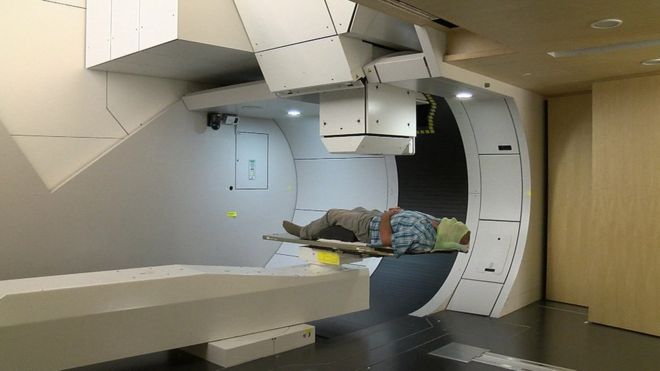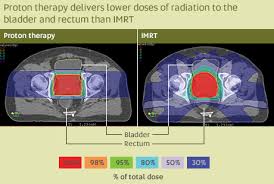Prostate matters is a not for profit organisation committed to providing free information about prostate issues from leading Clinical Authorities.
Prostate cancer treatment – Proton beam therapy

Consultant Clinical Oncologist
Guy’s and St Thomas’ NHS Foundation Trust

In 2022 , the options for the active treatment of non – metastatic prostate cancer are many .This provides men with many decisions to make , knowing that the chances of cure or control of localised prostate cancer are likely to be high but the side effects are different .
Within the non-surgical options are radiotherapy treatments which have also evolved significantly in the last 2 decades . This page concentrates on the use of proton beam therapy ( PBT ) – a less common form of external beam radiotherapy (EBRT ) .
Why might Protons be good a Cancer treatment?
Radiation is a form of energy which causes changes to the chromosomes or genetic material of cells as is passes through the body tissues . This damage preferentially kills cancer cells allowing normal body tissues to recover from the damage .
High energy Xrays deliver their highest dose of energy just under the skin and then fall away as they are absorbed passing deeper into the tissues . Protons are charged particles and deliver their majority of their energy at one depth – the Bragg peak and then stop beyond this point. The energy or strength of the proton beam is selected to have this peak where the tumour is to be treated .
Radiotherapy treatment is used to give a high dose of radiation to the target or tumour area and as little radiation as possible to the surrounding tissues – called organs at risk or OARs . Protons can be used in the treatment of children and young adults where precision delivering the treatment to the target is essential and avoiding lower doses of radiation in the surrounding OARs is important as these may cause further cancers later in life – second malignancies . Protons are also particularly beneficial treating around the brain , eyes and bony skull base and also where a high dose of radiation is needed to treat a cancer next to OARs which cannot tolerate this dose of radiation – such as head and neck , lung , oesophagus and in the abdomen and pelvis .
Why might Protons be good for treating Prostate Cancer ?
In the early 2000s , proton beam therapy machines became more widely available around the world and particularly in the USA . These machines had limited numbers of patients to treat and their attention turned to the treatment of prostate cancer with its large numbers of patients.
The prostate is seated in the central part of the pelvis , abutting the rectum and bladder in particular, both of which have limited tolerance to radiotherapy . The images shown demonstrate how neatly a proton beam can be used to target the prostate with limited doses of radiation outside. The proton beam spares tissues in front and behind and above and below the prostate from the excess unrequired radiation from X-rays. Although on a treatment plan this may look superior , this does not necessarily translate into symptomatic benefit for the patient .
The rectum can be separated from the prostate by a balloon or OAR spacer device which reduces the radiation dose to this sensitive organ by both protons and X-rays. The bladder is above and the penile bulb is below the prostate and the dose may be reduced a little by protons .
Cancers caused by treatment ( second malignancies ) are likely to be less in proton treatment , which avoids the low dose radiation surrounding the target when using X-rays. These cancers are rare and typically occur more than 10 years after the treatment was given – hence protons are used in children’s radiotherapy .
Sadly , there is no level 1 evidence comparing proton and X-ray treatment for early prostate cancer yet and clinical trials are now underway to answer this question .
How many treatments do I need?
The dose and numbers of radiotherapy fractions are similar for protons and X-rays.
For prostate only treatments , ultra hypofractionation is possible as used in published photon trials . A typical course of treatment would be 7 treatments given on alternate days .
For prostate and nodal radiotherapy , the treatment area is larger and we would tend to use smaller doses of daily radiation over 7 – 8 weeks .
When are protons most benefical in Prostate Cancer treatment ?
Protons have dosimetric advantages that lead to side effect reduction when the target area is more intricate than the prostate gland itself . Treatment to the prostate and pelvic lymph nodes for higher risk prostate cancer or those with nodal involvement is such a case . The bladder and bowel in the pelvis receive a much higher dose of radiation from X-rays which are likely to lead to side effects in the short and long term compared with protons which are sculpted better to the target areas .
Practical considerations in Prostate Cancer treatment
The cost of building and maintaining a Proton Beam facility are many times higher than an already costly radiotherapy department. In the UK, the NHS has proton machines in London and Manchester who treat mainly children and young adults as well as agreed tumour sites. These do not include prostate cancer radiotherapy . Private medical insurers will not usually cover the cost of proton treatment for prostate cancer which is a little higher .
Rutherford Cancer Centres have single gantry ( or 1 machine ) proton facilities around the UK . Travelling a distance for treatment can be inconvenient and stressful . There will be downtimes on the machines which may be unplanned and the back up facility may be a distance away – unlike X-rays where there will be several similar machines in 1 place . More proton facilities are likely to be built in the future as single gantries are a more affordable option and the use of protons increases .
Proton beam treatment is technically more complicated to deliver and each day the bowel and bladder need to be approximately the same size and shape as at planning . This is more critical for protons as more air or liquid in the treatment area will alter the proton plan more than X-rays. Bowel and bladder preparation for each treatment is important and can be troublesome .
What are the specific advantages of Photon Beam treatment?
- Excellent coverage of prostate target and especially nodal regions
- Reduced dose to surrounding structures
- May reduce side effects in bowel and bladder and penile bulb
- Evidence of reduction of second cancers caused by radiation
What are the downsides of Proton Beam treatment
- Not geographically close to most people in the UK
- High cost not covered by NHS or many health insurers
- Technically more difficult to deliver.
What prostate cancer stages can be treated?
We can treat the following prostate cancer stages with Protons. T1-T3b and if N1 or high risk cancer then nodes too.
That cancer ranging from T1, a small cancer lesion/tumour, through to T3 where the tumour has grown through the prostate on 1 side and into the tissue just outside the prostate up to T3b.That is where the tumour has grown into the seminal vesicle(s), the tube(s) that carry semen.
Further it can be used to treat local lymth node involement known as N1.
Click the button below for more information.
Summary
Proton beam treatment is one of many methods for treating prostate cancer . Its technical advantages are in limiting radiation doses to surrounding organs , which may reduce side effects . It has most benefit in more complex radiotherapy such as treating the prostate and nodal regions . It is not readily available in the UK at present and comes at a high cost .


Prostate matters is a not for profit organisation that is committed to providing free expert advice about prostate issues from leading Clinical Authorities
PROSTATE MATTERS
Copyright Disclaimer: We try to acknowledge copyright as appropriate. If we have used something without acknowledging copyright, this is inadvertent. Please let us know by emailing info@prostatematters.co.uk
Site design and technical development by Webtoys | Intelligent Digital Media


